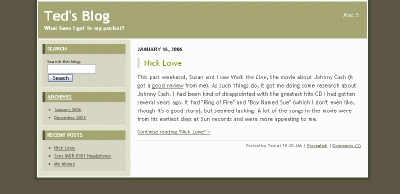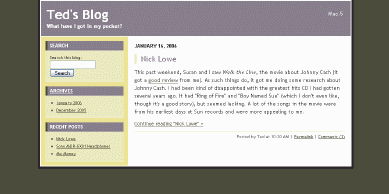It’s the beginning of the year so I used this past weekend to figure out how my investments did last year and decide where to put my 2006 installment of my Roth IRA. As you will recall, last December and January I had put the 2004 and 2005 contributions into Vanguard’s Small Cap Value Index. Small Cap stocks had a pretty good run prior to that time and this past year continued to (barely) outpace the Dow and S&P 500 (though medium sized companies did better than all of them in 2005). So I was going to leave that money where it was, but thought it was time to diversify the new contribution into something else.
I like international funds because they offer pretty good diversity from US stocks. I bought Janus Overseas back in 1998 and had been happy with it until it started lagging in 2002 and 2003 when I sold half of it and put it in a higher-rated (by Morningstar) fund, Fidelity Diversified International (which was actually the first foreign fund I had bought 1995, but I had to sell it to buy my house in 1997). I watched them both for two years as they went up in value at about the same impressive rate (40% in 2003, 20% in 2004). Meanwhile, in my Deferred Compensation account at work I had put 20% in American Europacific Growth and it had also done quite well. This past year Janus really leaped ahead, rising 32% to Fidelity’s 17%. So I'm glad I didn't abandon Janus entirely.
I looked at Vanguard’s Total International Stock Index fund which has only three holdings, each another Vanguard index fund for European, Asian, and emerging markets (I wanted some exposure to emerging markets since that is part of what helped Janus outperform Fidelity this year). But after thinking about it I decided that foreign stocks had probably enjoyed a good run, but couldn’t sustain it. I’m not selling any of my foreign funds, but I don’t think it is a good time to commit more money to that area either.
So that got me thinking that I needed to put money somewhere that didn’t do as well this year. Telecoms, technology, and pharmaceuticals didn’t do so great this year. Also large cap growth companies lagged. So I started looking for something like that. Vanguard had a few things, but possibly because of that lagging performance, a lot of their funds only got two stars out of five from Morningstar. I thought I could just put money in Vanguard’s large cap growth index fund. But then I found a fund that used to be called Vanguard Calvert Social Index. It is a 4-star fund and its performance was nearly identical to Vanguard’s Growth Index. Its top 3 holdings are Microsoft, Pfizer, and Johnson & Johnson: tech and pharmaceuticals. As a side bonus it doesn’t invest in tobacco, weapons, or nuclear power companies while it screens companies based on their human rights, labor practices, and environmental records. I thought that was worth something and it still seemed like a good investment. I found an article where a guy came up with an anti-social index of companies that are excluded and said they outperform the S&P 500 while the social index underperforms. But if that is true then why is the performance so close? (here’s a graph showing the 5-year performance of VCSIX (social index), VIGRX (the growth index) and the S&P 500 (GSPC)). I guess Calvert (who have their own mutual funds) wanted a license fee from Vanguard so in December Vanguard renamed their fund the FTSE Social Index, based on a similar index, FTSE4good, by the British company, FTSE (who donate their license fees for the social index to the UN). So I put my $4,000 on that horse. We’ll see how it does.
Interestingly, today the stock market had a big rally and everything that did well last year, continued to do really well. The Dow (large caps) was up by 1.2%, but the broader S&P 500 and small cap Russell 2000 were up 1.6% each. Meanwhile Janus picked right up where it was and rose 2.6% along with Fidelity. The FTSE fund, meanwhile was up only 1.4%. But I didn’t want it to go up today since I was buying at the closing price (that 1.4% rally cost me $56).



